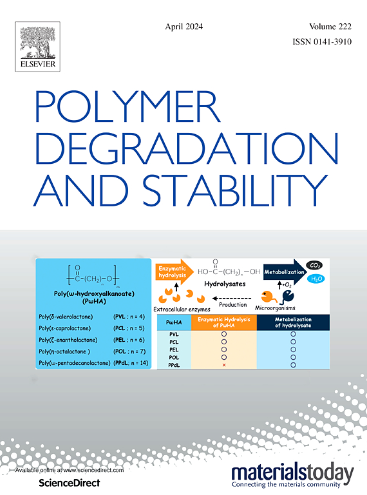Highly tunable platinum-based catalysts: Dual control of shelf stability and thermal degradation behavior in silicone rubber
IF 7.4
2区 化学
Q1 POLYMER SCIENCE
引用次数: 0
Abstract
In this study, a phosphorus-containing monofunctional silicone (PMS) was synthesized through an epoxy ring-opening reaction between 1,3-bis(3-glycidoxypropyl)-1,1,3,3-tetramethyldisiloxane (MgoMgo) and (diphenylphosphino) benzoic acid (DPPBA). Subsequently, phosphino-modified MQ silicone resins (PSR) with tailored functionalization characteristics were synthesized utilizing the PMS, followed by systematic evaluation of their effect of shelf stability in liquid silicone rubber (LSR) curing systems. The influence of (1) phosphorus (P): platinum (Pt) ratio, (2) functionalization duration, and (3) M/Q ratio of PSR on platinum catalyst activity, along with the underlying mechanisms, were systematically investigated through Fourier-transform infrared spectroscopy (FTIR), scanning electron microscopy-energy dispersive spectroscopy (SEM-EDS), and electron probe microanalysis (EPMA). Experimental analyses demonstrate that adjustment of the previous three key parameters exerts precise control over the inhibitory properties within PSR, resulting in a highly tunable latency of the Pt catalysts. Thermogravimetric (TG) analysis revealed that the incorporation of PSR increased the residual rate of LSR by 18.99 % at 800 °C. TG-FTIR investigations further demonstrate that the PSR significantly promotes the organic-to-inorganic conversion of LSR. Characterization of the thermal stability of the Pt catalyst and X-ray photoelectron spectroscopy (XPS) of the LSR residues at 800 °C revealed that the PSR effectively stabilizes atomically dispersed Pt. This stabilization decelerates platinum aggregation at elevated temperatures through strong ligand bonding, thereby enhancing the catalytic efficiency of Pt at 800 °C.

高度可调的铂基催化剂:硅橡胶中货架稳定性和热降解行为的双重控制
本研究以1,3-二(3-甘氧基)-1,1,3,3-四甲基二硅氧烷(MgoMgo)和(二苯基膦)苯甲酸(DPPBA)为原料,通过环氧开环反应合成了含磷单官能团有机硅(PMS)。随后,利用PMS合成了具有定制功能化特性的磷酸基改性MQ有机硅树脂(PSR),并对其在液态硅橡胶(LSR)固化体系中的货架稳定性进行了系统评价。通过傅里叶变换红外光谱(FTIR)、扫描电镜-能谱(SEM-EDS)和电子探针微量分析(EPMA)系统研究了(1)磷(P):铂(Pt)比、(2)功能化持续时间和(3)PSR的M/Q比对铂催化剂活性的影响及其机制。实验分析表明,调整上述三个关键参数可以精确控制铂催化剂在PSR内的抑制性能,从而实现铂催化剂的高可调延迟。热重(TG)分析表明,在800℃时,PSR的加入使LSR的残留率提高了18.99%。TG-FTIR研究进一步表明,PSR显著促进了LSR的有机到无机转化。对Pt催化剂的热稳定性和800℃下LSR残留物的x射线光电子能谱(XPS)的表征表明,PSR有效地稳定了原子分散的Pt。这种稳定化通过强配体键抑制了铂在高温下的聚集,从而提高了Pt在800℃下的催化效率。
本文章由计算机程序翻译,如有差异,请以英文原文为准。
求助全文
约1分钟内获得全文
求助全文
来源期刊

Polymer Degradation and Stability
化学-高分子科学
CiteScore
10.10
自引率
10.20%
发文量
325
审稿时长
23 days
期刊介绍:
Polymer Degradation and Stability deals with the degradation reactions and their control which are a major preoccupation of practitioners of the many and diverse aspects of modern polymer technology.
Deteriorative reactions occur during processing, when polymers are subjected to heat, oxygen and mechanical stress, and during the useful life of the materials when oxygen and sunlight are the most important degradative agencies. In more specialised applications, degradation may be induced by high energy radiation, ozone, atmospheric pollutants, mechanical stress, biological action, hydrolysis and many other influences. The mechanisms of these reactions and stabilisation processes must be understood if the technology and application of polymers are to continue to advance. The reporting of investigations of this kind is therefore a major function of this journal.
However there are also new developments in polymer technology in which degradation processes find positive applications. For example, photodegradable plastics are now available, the recycling of polymeric products will become increasingly important, degradation and combustion studies are involved in the definition of the fire hazards which are associated with polymeric materials and the microelectronics industry is vitally dependent upon polymer degradation in the manufacture of its circuitry. Polymer properties may also be improved by processes like curing and grafting, the chemistry of which can be closely related to that which causes physical deterioration in other circumstances.
 求助内容:
求助内容: 应助结果提醒方式:
应助结果提醒方式:


